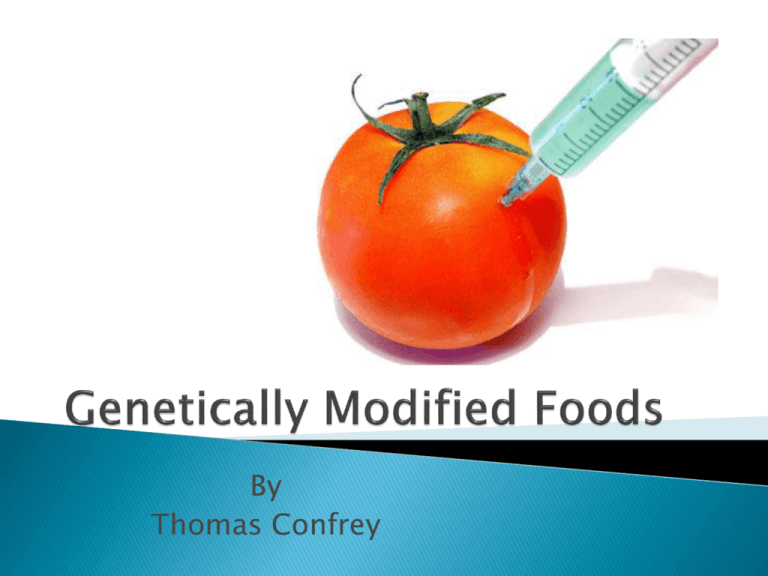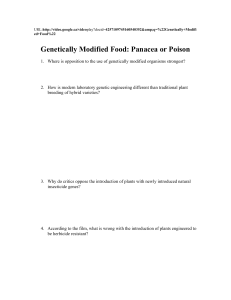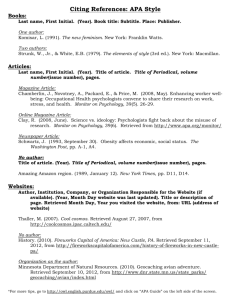Genetically Modified Foods - Wikispaces
advertisement

By Thomas Confrey Happening since the Neolithic Revolution Three Common Methods ◦ Selective Breeding ◦ Combing/Hybridizing Species ◦ Exploiting Natural Mutations Modern genetic modification involves tranfer of DNA Cisgenesis – genes transferred from similar species Trangensis- genes transferred from dissimilar species Food allergies are a problem for many Americans. (e.g. Soy, peanuts, seafood, etc) New genetically modified species means infinitely more proteins Usually, allergies are only discovered after an individual has a violent reaction. Predicting allergies is nearly impossible GM Plants designed to keep bugs/animals away GM Plants take up more chemicals including heavy metals Chemical companies often design new pesticides and herbicides, as well as, genetically modified plants, which are “immune” to them. New pesticides or herbicides can seep into surface and ground water •Dangerous Unnatural •An Necessary Option •Risks outweigh any ◦Stems from ◦World hunger is US out •Opinion of the benefits moral/ethical dilemma of control government Currently Genetically Modified foods do not need special labels Genetically Modified Foods are not going away Could be used to eliminate artificial dyes, preservatives and steroids Still need more research and long-term testing/risk assessment Fertilizer is a major problem Biotechnology. (n.d) Retrieved November 20, 2009 from Earth: A Graphic Look at the State of the World: http://images.google.com/imgres?imgurl=http://www.theglobaleducationpro ject.org/earth/images/components/biotech-patent-chart-copy... FDA Issues Final Guidance on Regulation of Genetically Engineered Animals. (2009, January 25). Retrieved November 11, 2009, from FDA: www.fda.gov/consumer/updates/ge_animals011509.html Fewer, L. J. (2004). Societal aspects of genetically modified foods. Food and Chemical Toxicology , 1181-1193. Genetically Modified (GM) Plants. (2005, September 21). Retrieved November 23, 2009, from The Naked Scientists: http:www.thenakedscientists.com/HTML/articles/article/marktester... Genetically Modified Crops. (2008, October 29). Retrieved November 23, 2009, from VOA News: http://www.voanews.com/uspolicy/2008-10-30 voa1.cfm?renderforpr... GENETICALLYMODIFIED FOODS Experts View Regimen of Safety Tests as Adequate, but FDA's Evaluation Process Could Be Enhanced. (2002) Retrieved November 20, 2009, from GAO: http://www.gao.gov/new.items/d02566.pdf Harvest of Fear. (2009). Retrieved November 2, 2009, from PBS: http://www.pbs.org/wgbh/harvest/exist/arguments.html How to feed the world. (2009, November 19). Retrieved November 23, 2009, from Economist: http://www.economist.com/opinion/PrinterFriendly.cfm?story_id=149... LaFranchi, H. (2009, November 15). On eve of UN food summit: 20 best ways to feed the hungry. Retrieved November 25, 2009, from The Christian Science Monitor:http://www.csmonitor.com/2009/1115/p02s01usfp.htm?print=true Morales, A. (2009, January 29). 'GM Crops' Part of Food Crisis Solution, U.K. Says. Retrieved 11 21, 2009, from Bloomberg: http://www.bloomberg.com/apps/news?pid=20670001&sid=aYDn4... News & Events Genetically Engineered Foods. (1999, October 19). Retrieved 11 19, 2009, from FDA: http://www.fda.gov/NewsEvents/Testimony/ucm115032.htm Prescott, V. E. (2006). Genetically modified plants and food hypersensitivity diseases: Usage and implications of experimental models for risk assessment. Pharmacology & Therapeutics , 374-383. Risks of Genetic Engineering. (n.d.). Retrieved November 21, 2009, from Union of Concerned Scientists: http://www.ucsusa.org/food_and_agriculture/science_and_impacts/imp... Roundup Ready Soybeans. (n.d.). Retrieved November 11, 2009, from Union of Concerned Scientists: http://www.ucsusa.org/food_and_agriculture/science_and_impacts /imp.. Saher Marieke, M. L.-K. (2006). Attitudes towards genetically modified and organic foods. Appetite , 324-331. Salzano, G. a. (2009, October 16). World's Hungry Pass 1 Billion as Wealth Increases: Chart of the Day. Retrieved November 23, 2009, from Bloomberg: http://www.bllomberg.com/apps/news?pid=20670001&sid=a_2ti W.. Schouten, Henk J, Frans A Krens, and Evert Jacobsen. Cisgenic plants are similar to traditionally bred plants: International regulations for genetically modified organisms should be altered to exempt cisgenesis, European Molecular Biology Organization. 2006 August; 7(8): 750–753 World goes for GM crops to tackle food crisis. (n.d.). Retrieved November 20, 2009, from Commodity Online: http://www.commodityonline.com/printnews.php?news_id=13405





